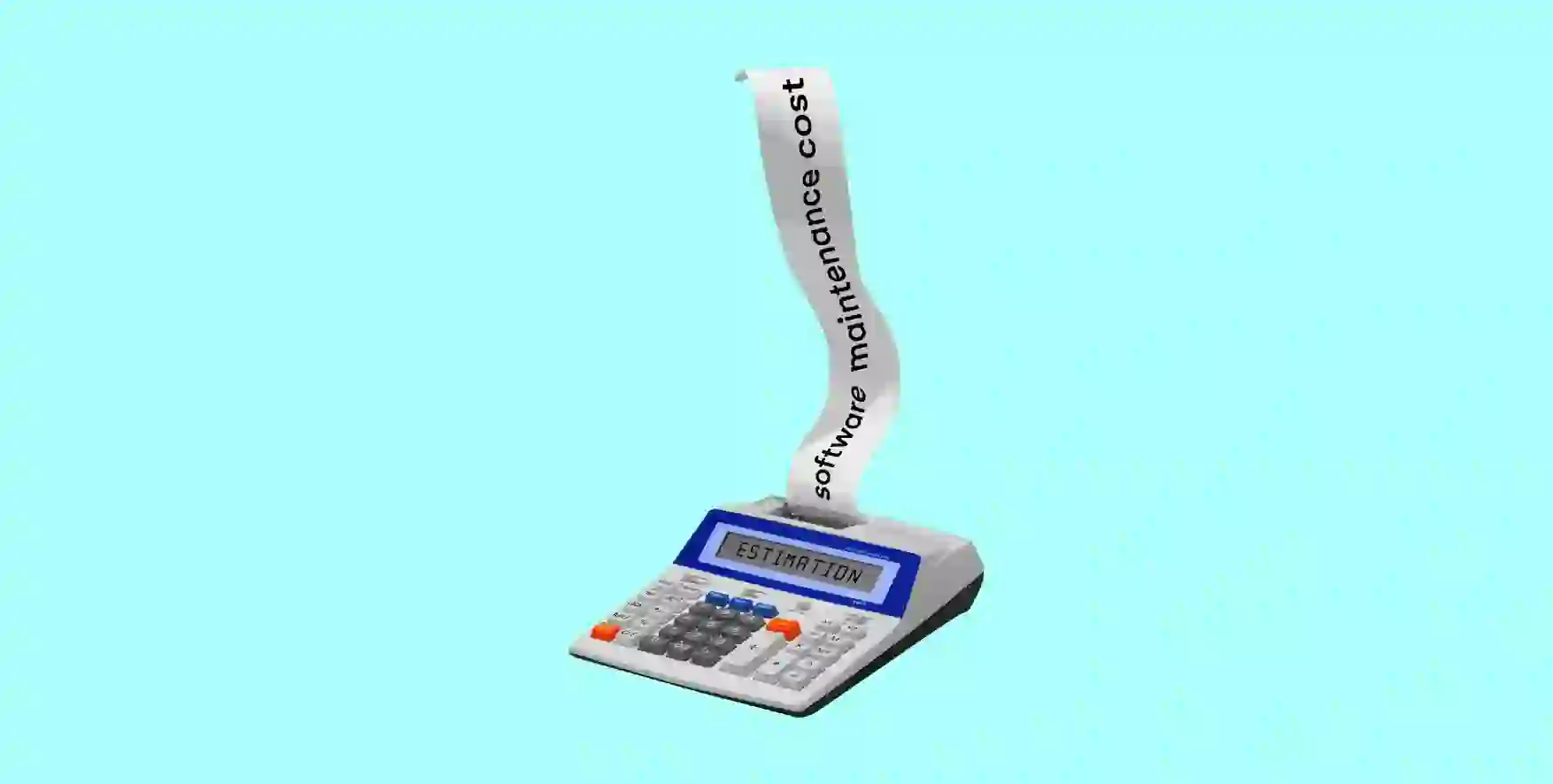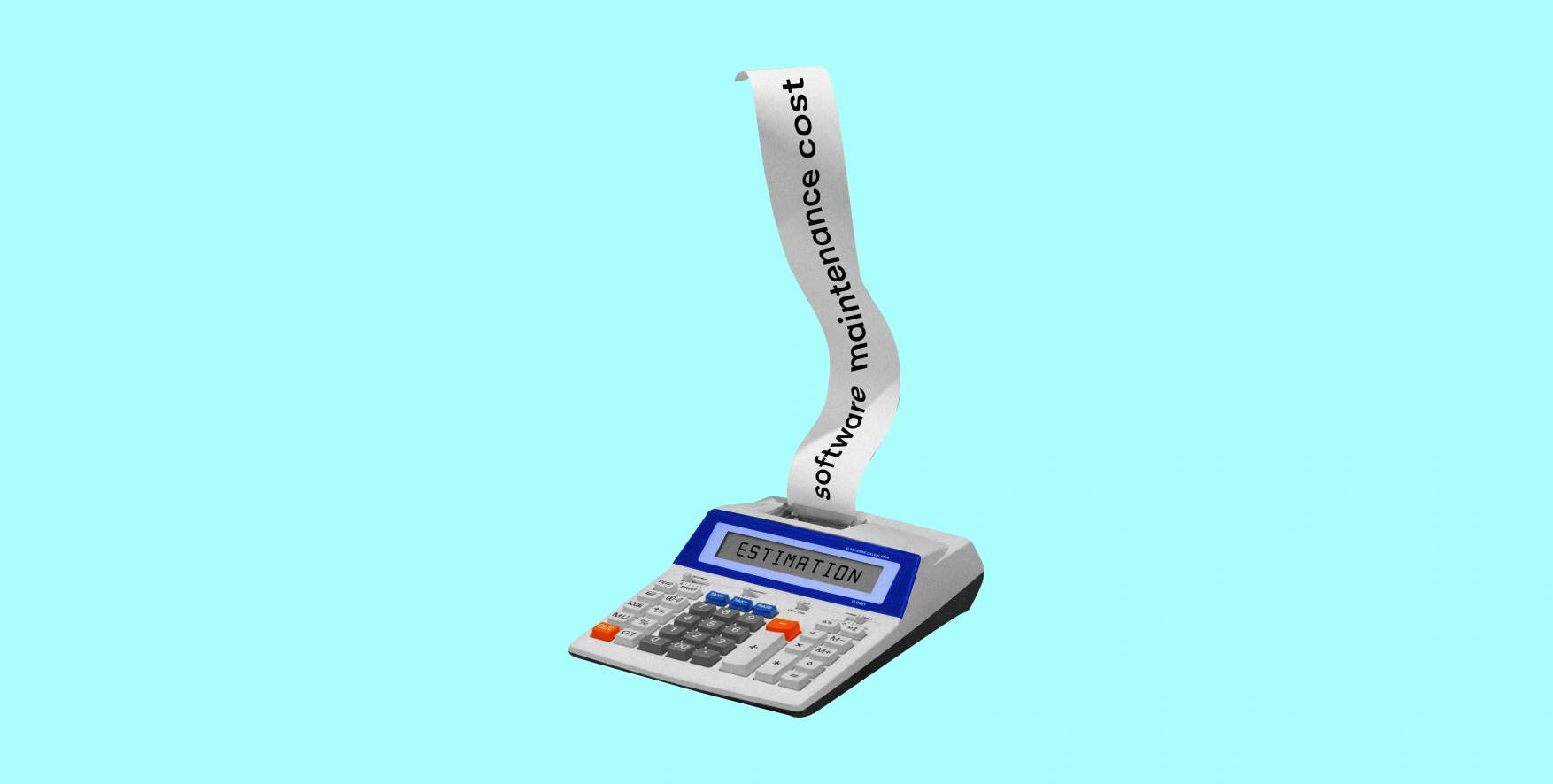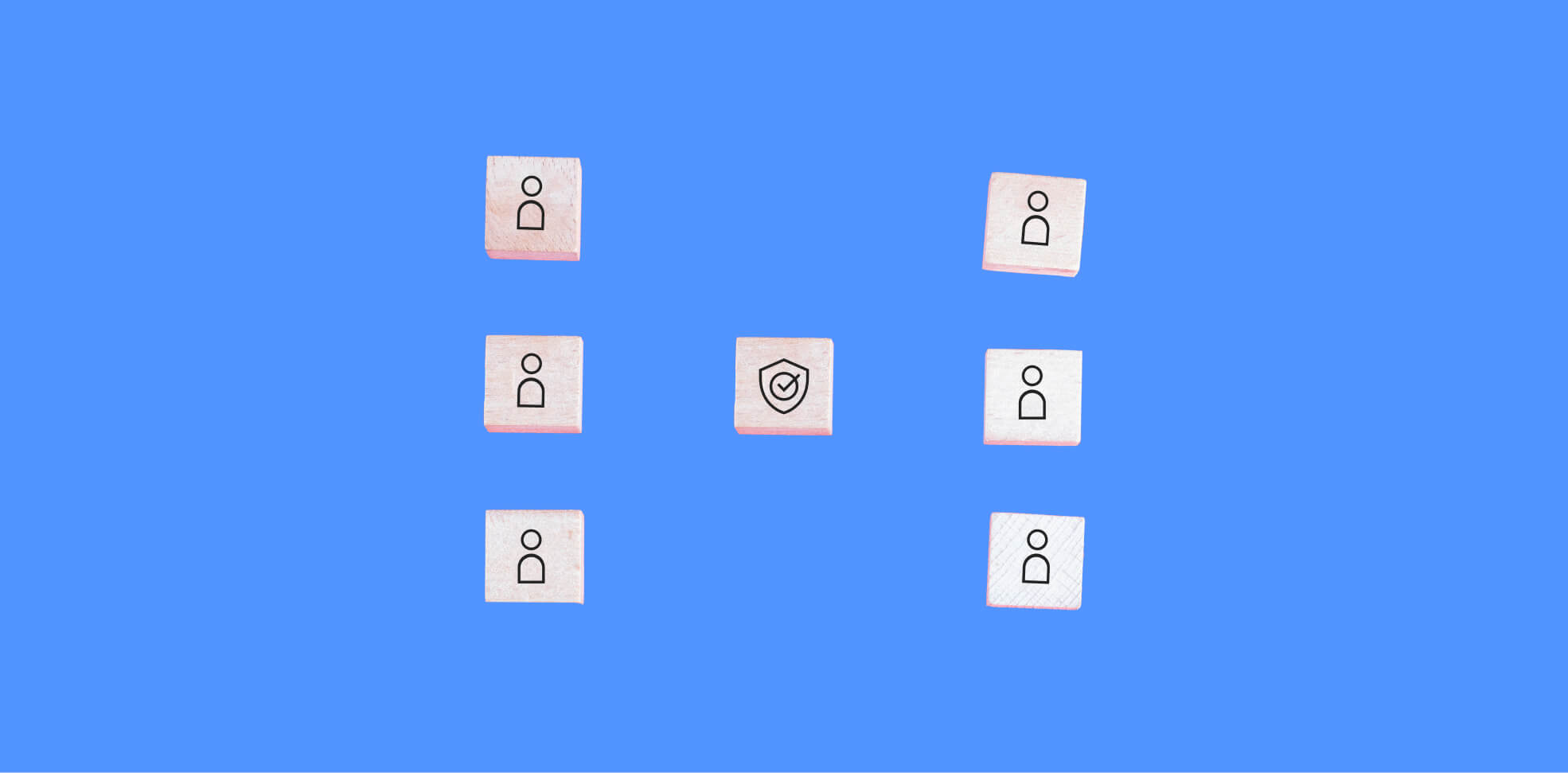In the dynamic and ever-evolving landscape of technology, navigating the intricacies of software maintenance costs is pivotal for startups and small to medium-sized businesses (SMBs) alike. This comprehensive guide aims to delve into the various dimensions of software maintenance costs, ranging from understanding the inclusive services to exploring the factors that influence pricing and providing step-by-step guidance for accurate software project cost estimation.
The cost of software maintenance is the expense associated with updating, repairing, and enhancing software after its initial deployment. This includes bug fixes, performance improvements, security updates, and adapting the software to new hardware or operating systems. Understanding these costs is crucial for ensuring the long-term functionality and reliability of software solutions while managing budget allocations effectively.
What does software maintenance include?
The definition of software maintenance services is a comprehensive and strategic approach designed to ensure a software application's seamless operation, security, and relevance throughout its entire lifecycle. It goes beyond the initial development phase, focusing on activities that contribute to the sustained health and performance of the software. These activities encompass a multifaceted range of services, making up a well-crafted software maintenance plan that is the bedrock for the application's longevity and optimal functionality.
Key components of software maintenance
Bug fixes
Software maintenance involves identifying and resolving bugs or issues within the application's code. This process is crucial for eliminating disruptions and improving the overall user experience. Regular bug fixes contribute to a stable and error-free software environment, ensuring users encounter fewer issues and reducing potential business disruptions.
Updates
Keeping the software up-to-date involves implementing patches, improvements, and modifications to address evolving user needs, industry standards, and emerging technologies. Regular updates enhance the software's features, security, and compatibility, allowing it to adapt to changing environments and user expectations.
Enhancements
Software maintenance includes enhancing the application's functionality, performance, and user interface. This proactive approach ensures that the software evolves to meet user demands and technological advancements. Continuous enhancements contribute to a positive user experience, keeping the software aligned with industry trends and ensuring its competitiveness in the market.
Ongoing technical support
Providing continuous technical support involves addressing user queries, troubleshooting issues, and offering guidance on software usage. It ensures that users have a reliable resource for resolving challenges encountered during application use. Ongoing technical support fosters user satisfaction, establishes a positive rapport between users and the software provider, and contributes to the application's long-term success.
ESTIMATE SOFTWARE MAINTENANCE COSTS
Use our calculator tool to estimate the average cost of software maintenance for your project.
Types of software maintenance services
Corrective maintenance
Corrective maintenance involves identifying and fixing issues or bugs that may arise in the software. This type of maintenance is reactive, addressing problems as they are discovered.
Example of a cost calculation: The annual calculated cost for corrective maintenance typically ranges from $5,000 to $20,000, depending on the complexity of the software and the volume of identified issues.
Adaptive maintenance
Adaptive maintenance focuses on adapting the software to changes in the environment, such as updates to the operating system or hardware changes. This proactive approach ensures the software remains compatible with the evolving technological landscape.
Example of a cost calculation: Businesses can calculate an annual price ranging from $10,000 to $30,000 for adaptive maintenance, considering the need for adjustments due to environmental changes.
Perfective maintenance
Perfective maintenance involves enhancements and optimizations to improve the software's functionality or performance. This type of maintenance is geared towards refining the software based on user feedback and changing requirements.
Example of a cost calculation: Calculated annual fees for perfective maintenance vary between $15,000 and $40,000, depending on the extent of enhancements and optimizations.
Preventive maintenance
Preventive maintenance is a proactive strategy to identify and address potential issues before they impact the software's performance. This type of maintenance helps in minimizing the occurrence of critical problems.
Example of a cost calculation: Businesses may allocate an average of $8,000 to $25,000 annually for preventive maintenance, ensuring the proactive identification and resolution of potential issues.
Why are software maintenance services essential for businesses?
The significance of software maintenance services for businesses cannot be overstated, as they contribute to several critical aspects of operational efficiency and user satisfaction:
Enhanced performance
Regular updates and optimizations resulting from maintenance activities contribute to the seamless and efficient performance of the software, preventing performance bottlenecks and ensuring a smooth user experience. For example, a well-maintained ecommerce platform can experience a 20% increase in page loading speed, leading to higher user satisfaction and conversion rates.
Security
Ongoing maintenance is paramount for addressing vulnerabilities in the software, reducing the risk of security breaches, and safeguarding sensitive data. Regular security updates and patches can help a financial application maintain compliance with industry standards, ensuring the protection of users’ financial information.
Adaptability
Adaptive maintenance ensures that the software remains compatible with evolving technologies and platforms, allowing businesses to integrate with new systems and maintain a competitive edge seamlessly. An adaptable CRM software can seamlessly integrate with a new third-party customer communication tool, enhancing overall business communication and efficiency.
User satisfaction
Continuous improvements and bug fixes resulting from maintenance efforts contribute to a positive user experience, fostering customer satisfaction and loyalty. Regular updates to a mobile banking app can address user-reported issues, leading to positive app store reviews and increased user retention.
GET A CUSTOM SOFTWARE MAINTENANCE QUOTE
Our team is here to consult you on our software maintenance services and calculate the cost of software maintenance for your particular project.
Factors affecting software maintenance cost
Various technical and non-technical factors influence maintenance software prices, each significantly determining the overall expenditure. A deeper understanding of these factors is essential for businesses to conduct accurate cost estimation, calculate the price of hiring software developers and effective budget planning.
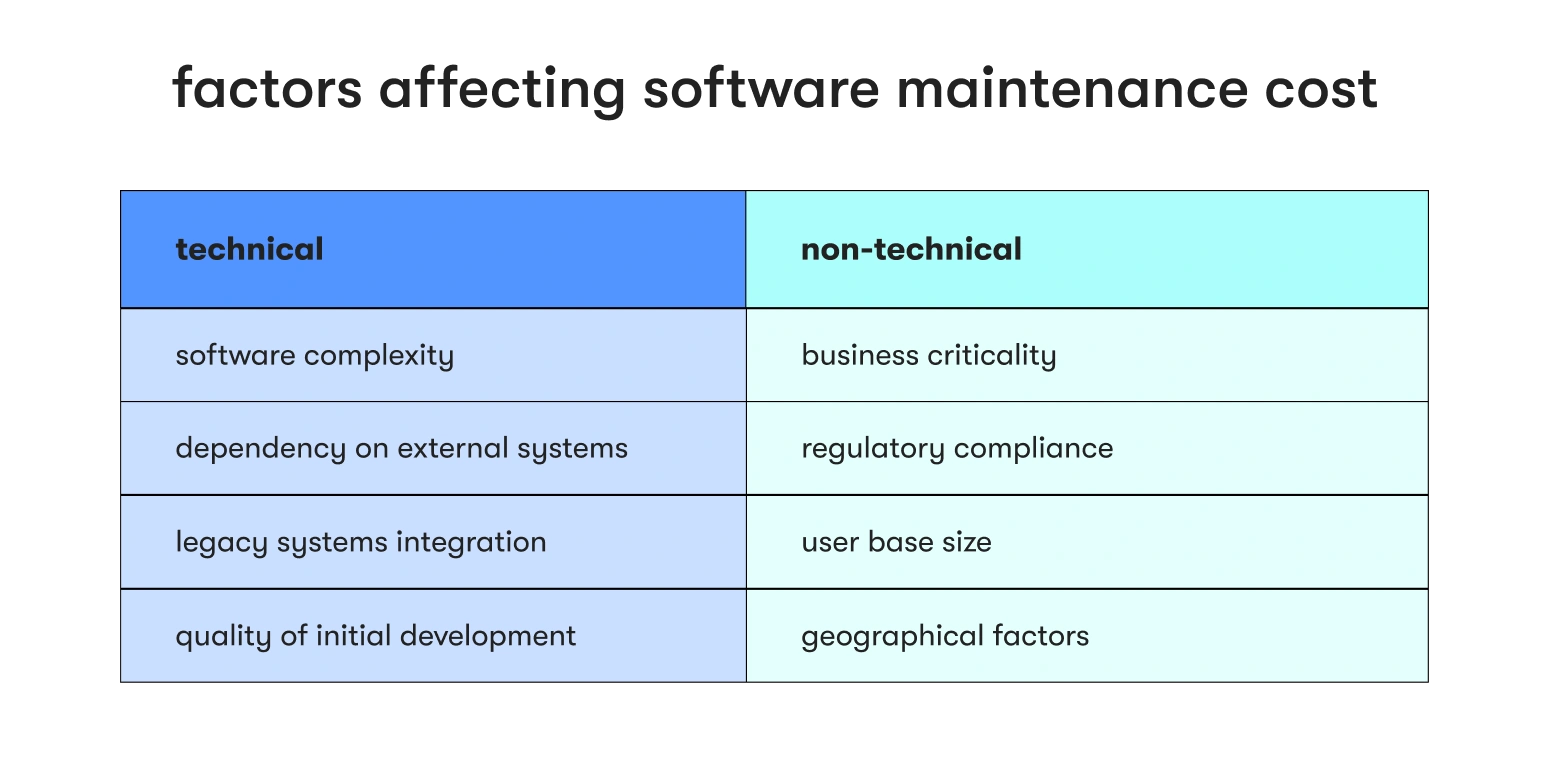
Technical factors
Software complexity
The complexity of the software architecture and design is a critical factor influencing the average cost of software maintenance. More complex systems may require increased time and resources for ongoing application maintenance and support.
Impact: An intricate enterprise resource planning (ERP) system may incur maintenance costs ranging from $50,000 to $150,000 annually, reflecting the resources required to navigate its complexity.
Dependency on external systems
If the software relies on external systems or third-party services, changes or disruptions in those systems can significantly impact maintenance costs.
Impact: Integration with a critical external API may introduce additional maintenance costs of $10,000 to $30,000 annually, reflecting the need for adjustments based on external changes.
Legacy systems integration
Integrating with or maintaining legacy systems may pose challenges, potentially increasing maintenance costs as the software evolves.
Impact: Integrating a software solution with legacy systems could contribute an additional $20,000 to $50,000 annually, reflecting the complexities and potential complications associated with legacy systems.
Quality of initial development
The initial software development significantly impacts maintenance costs over time. A well-developed foundation minimizes the occurrence of bugs and issues, resulting in more cost-effective maintenance.
Impact: High-quality initial development may reduce annual maintenance costs by 15-30%, reflecting the long-term cost benefits of investing in robust development practices.
Non-technical factors
Business criticality
The criticality of the software to core business functions influences maintenance costs. Mission-critical applications may necessitate more extensive and regular support.
Impact: Critical business applications may require maintenance software prices ranging from $80,000 to $200,000 annually, reflecting the heightened importance and urgency of supporting these systems.
Regulatory compliance
Software subject to specific industry regulations or compliance standards may incur additional maintenance costs to ensure ongoing adherence.
Impact: Maintaining compliance with industry standards could contribute an extra $15,000 to $40,000 annually, reflecting the additional efforts and resources required to adhere to regulatory requirements.
User base and usage
The user base size and the software usage intensity can impact maintenance costs. High-demand applications may require more frequent updates and support.
Impact: Software with a large user base may increase maintenance software prices by 20-40% annually, reflecting the additional resources required to support a larger user community.
Geographical factors
The geographical distribution of users can influence maintenance costs, especially if localization or specific regional requirements are essential.
Impact: Implementing software localization may introduce an additional cost of $10,000 to $25,000 annually, reflecting the resources required to tailor the software to different linguistic and cultural contexts.
DISCOVER OUR SOFTWARE MAINTENANCE SERVICES
Discuss your project requirements with our expert team and start maintenance confidently.
How to reduce software maintenance cost
Accurately estimating software maintenance costs is a crucial aspect of effective budget planning and ensuring the long-term success of your software application. This process involves a strategic approach, considering various maintenance expenditure factors and minimizing their burden on your project budget. Below are detailed steps to guide you in reducing your software maintenance costs:
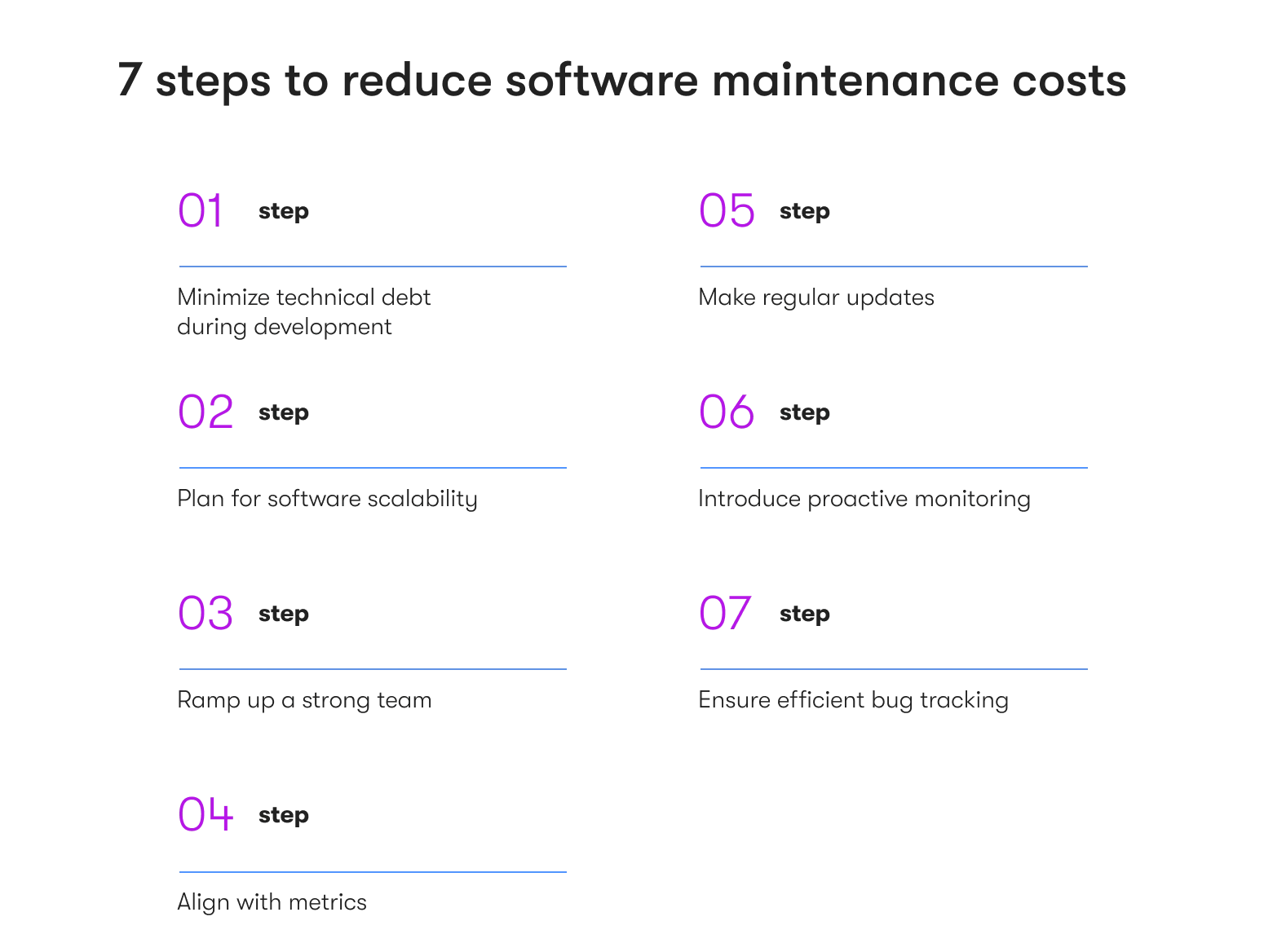
Step 1: Minimize technical debt during development
The foundation of your software significantly influences maintenance costs. By starting with a robust and well-architected application, you minimize the occurrence of bugs and issues that may lead to extensive maintenance efforts. Our software engineering services are designed to ensure your application begins with a solid foundation, promoting reliability and longevity from the outset.
Step 2: Plan for software scalability
Scalability plays a pivotal role in long-term cost management. As your business grows, your software should be able to accommodate increased demands without incurring disproportionately higher maintenance costs. Our specialized team excels in creating scalable solutions that evolve seamlessly with your business, providing cost-effective scalability management.
Step 3: Ramp up a strong team
Building and maintaining a competent team is paramount for effective software development and subsequent maintenance. Our expertise lies in assembling and managing highly skilled software development teams. Leveraging our experience ensures your team is well-equipped to handle ongoing maintenance challenges, contributing to cost-efficient and reliable software support.
Step 4: Align with metrics
Regularly monitoring analytics is a proactive strategy to identify potential issues early on, preventing them from evolving into critical problems. Our support services include ongoing analytics checks, ensuring optimal software performance by addressing emerging issues promptly. This iterative approach to analytics monitoring contributes to a more streamlined and cost-effective maintenance process.
Step 5: Make regular updates
Keeping software up-to-date prevents the accumulation of issues, reducing the need for extensive maintenance. A regular update schedule may contribute to a 15% reduction in annual maintenance costs as fewer critical issues arise.
Step 6: Introduce proactive monitoring
Implementing proactive monitoring helps identify and address potential issues before they become critical, minimizing the resources required for reactive maintenance. Proactive monitoring can significantly reduce maintenance costs, as issues are identified and addressed before they impact software performance.
Step 7: Ensure efficient bug tracking
Streamlining bug tracking and resolution processes minimizes the resources dedicated to corrective maintenance, improving overall cost efficiency. An efficient bug tracking system can result in a 25% reduction in maintenance costs, as issues are identified, addressed, and resolved more expediently.
Software maintenance costs examples
Example 1: Startup with a custom software application
Imagine a startup that has developed a customized software application crucial for its operations. In the initial post-development phases, this startup incurs an average annual maintenance cost of approximately $50,000.
This comprehensive cost breakdown includes:
- Bug fixes: $15,000 annually
The startup allocates resources to identify and resolve bugs promptly, ensuring a seamless user experience for their product.
- Updates: $20,000 annually
Regular updates are implemented to introduce new features and enhancements based on evolving user needs.
- Technical support: $15,000 annually
Ongoing technical support is provided to address user queries and troubleshoot issues promptly.
Example 2: Established business with a complex software ecosystem
Now, consider an established business that relies on a sophisticated software ecosystem for its extensive operations. In this context, the estimated annual maintenance cost is around $120,000, reflecting the intricacies of maintaining a multifaceted software infrastructure:
- Adaptive maintenance: $40,000 annually
The business invests significantly in adaptive maintenance to ensure seamless compatibility with changes in the technological landscape.
- Ongoing improvements: $50,000 annually
Continuous enhancements and optimizations are a priority to keep the software ecosystem aligned with changing user expectations.
- Comprehensive technical support: $30,000 per year
Robust technical support addresses complex issues, ensuring minimal disruptions to critical business operations.
By examining these real-world examples with concrete monetary values, businesses gain valuable insights into the nuanced components and associated costs of maintaining their software applications. These examples underscore the importance of tailoring maintenance efforts to specific business needs, ultimately contributing to software assets' sustained health and performance.
Conclusion
In conclusion, understanding the cost of software maintenance is crucial for startups and SMBs aiming to optimize their budgets and ensure the longevity of their applications. Businesses can confidently navigate the software maintenance landscape by considering various factors, estimating prices accurately, and implementing strategic measures.
Explore our software maintenance services to ensure your applications' continuous health and performance.

Anush has a history of planning and executing digital communications strategies with a focus on technology partnerships, tech buying advice for small companies, and remote team collaboration insights. At EPAM Startups & SMBs, Anush works closely with subject matter experts to share first-hand expertise on making software engineering collaboration a success for all parties involved.
Anush has a history of planning and executing digital communications strategies with a focus on technology partnerships, tech buying advice for small companies, and remote team collaboration insights. At EPAM Startups & SMBs, Anush works closely with subject matter experts to share first-hand expertise on making software engineering collaboration a success for all parties involved.
Explore our Editorial Policy to learn more about our standards for content creation.
read more